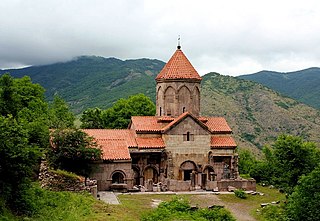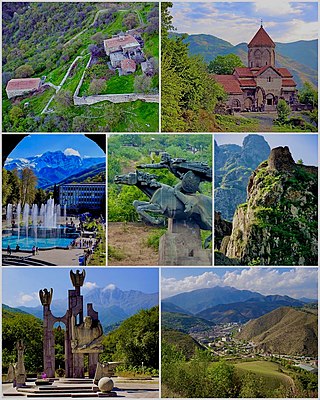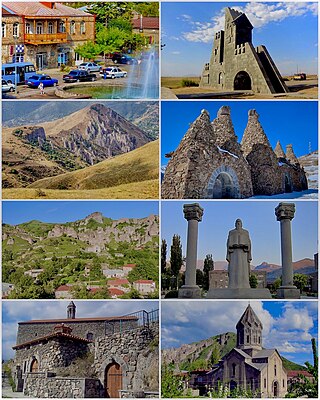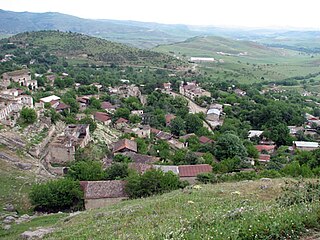
Syunik is the southernmost province of Armenia. It is bordered by the Vayots Dzor Province to the north, Azerbaijan's Nakhchivan Autonomous Republic exclave to the west, Azerbaijan to the east, and Iran to the south. Its capital and largest city is the town of Kapan. The Statistical Committee of Armenia reported its population was 141,771 in the 2011 census, down from 152,684 at the 2001 census.

Kapan is a town in southeast Armenia, serving as the administrative centre of the Kapan Municipality and also as the provincial capital of Syunik Province. It is located in the valley of the Voghji River and is on the northern slopes of Mount Khustup. Kapan is the most populous town in the Syunik Province as well as the entire region of southern Armenia. According to the 2011 census, the population of Kapan was 43,190, a slight decline from 45,711 in the 2001 census. According to the 2022 census, the current population of the town is around 32,780.

Goris is a town and the centre of the Goris Municipality in the Syunik Province in southern Armenia. Located in the valley of the Goris River, it is 254 kilometres from the Armenian capital Yerevan and 67 kilometres from the provincial capital Kapan. Goris is the second largest city in Syunik in terms of population. As of the 2022 census, it had a population of 17,113, down from the 20,591 reported in the 2011 census. Goris is the seat of the Diocese of Syunik of the Armenian Apostolic Church.

Davit Bek or David Beg was an Armenian military commander and the leader of an Armenian rebellion against the invading Ottoman Empire and implanted Safavid Muslim tribes in the mountainous region of Zangezur. He was one of the most prominent military figures of the Armenian liberation movement of the 18th century.

Sero Nikolayi Khanzadyan was a Soviet and Armenian writer and novelist.

Tegh is a village and the center of the Tegh Municipality of the Syunik Province in Armenia. Tegh is the last village on the Goris-Stepanakert Highway before passing the border with Azerbaijan.

Aghitu is a village in the Sisian Municipality of the Syunik Province in Armenia. It is located on the left bank of the Vorotan river, 7 kilometers east of the regional capital of Sisian.

Davit Bek is a village in the Kapan Municipality of the Syunik Province in Armenia. Located in the Kashun river valley, 28 kilometers from the regional center of Kapan, it lies 1150 meters above sea level. It is named after the Armenian patriotic leader David Bek.

Drakhtik is a village in the Shoghakat Municipality of the Gegharkunik Province of Armenia.
Geghi is a village in the Kajaran Municipality of the Syunik Province in Armenia.
Gtashen is a village in the Amasia Municipality of the Shirak Province of Armenia.

Karchevan is a village in the Meghri Municipality of the Syunik Province in Armenia.

Khot is a village in the Tatev Municipality of the Syunik Province in Armenia. It is located on the left side of the Vorotan river, 67 kilometers from the regional center of Kapan. On the cliffs below Khot are the ruins of Hin Khot, the previous location of the village until the 1970s.

Nerkin Khndzoresk is a village in the Goris Municipality of the Syunik Province in southeastern Armenia. Nerkin Khndzoresk is located close to the border, and is located 21 km from Goris of the Stepanakert highway. The village lies 7 km from the Khndzoresk village connected by farm fields and one dirt road. The remote village is positioned below the larger village and is surrounded by rolling hills, gorges, and scenic mountains.
Nrnadzor is a village in the Meghri Municipality of the Syunik Province in Armenia, on the bank of the Aras River.

Shurnukh is a village in the Goris Municipality of the Syunik Province in Armenia.

Askeran is a town in the Khojaly District of Azerbaijan, in the region of Nagorno-Karabakh. Until 2023 it was controlled by the breakaway Republic of Artsakh, as the centre of its Askeran Province. The town had an ethnic Armenian-majority population until the exodus of the Armenian population of Nagorno-Karabakh following the 2023 Azerbaijani offensive in Nagorno-Karabakh. It is located on the left bank of the Karkar River (Qarqarçay), approximately 11 kilometres (7 mi) northeast of the regional capital, Stepanakert.

Tugh or Togh is a village in the Khojavend District of Azerbaijan, in the region of Nagorno-Karabakh. The village had a mixed Armenian-Azerbaijani population before the First Nagorno-Karabakh War, the Azerbaijani inhabitants fled the fighting in 1991, and the Armenian population fled the village during the 2020 Nagorno-Karabakh war.

Mkhitar Sparapet, also known as Mkhitar Bek, was an 18th-century Armenian military commander and participant in the Armenian armed rebellion in the Syunik region of Transcaucasia. He was instrumental in David Bek's victories over the forces of Safavid Iran and the Ottoman Empire in Armenia's Syunik region. Their main headquarters were at the fortress of Halidzor which also served as the administrative center for Syunik. Mkhitar served as chief aide to David Bek and later his successor after his death in 1728.

The Syunik rebellion of 1722–1730 began as a rebellion of the Armenians of the region of Syunik in Iranian Armenia against Safavid rule and local Muslim tribes and rulers. Under the leadership of Davit Bek, an Armenian soldier from Georgia, the Armenian lords (meliks) of Syunik were united and an independent Armenian principality was established. From 1725, the Armenian principality of Syunik resisted the Ottoman Empire's attempts to occupy the region. After making initial gains and occupying a significant part of the province, the Ottomans were defeated at the Battle of Halidzor on 26 February 1727. After this victory, Davit Bek's forces completely drove the Ottomans out of Syunik, and he was recognized by the Safavid shah Tahmasp II as ruler of Ghapan. After his death in mid-1728, Davit Bek was succeeded by one of his commanders, Mkhitar Sparapet. In a renewed assault, the Ottomans captured and destroyed Halidzor in early 1729, forcing Mkhitar to flee. Although Mkhitar continued to resist the Ottomans and won some victories, he was killed by a group of Armenian villagers in Khndzoresk. Left leaderless, the Armenian forces dispersed, and the Ottomans occupied Syunik, although some Armenians continued to resist from impregnable mountainous areas. The rebellion occurred at the same time as, and occasionally directly cooperated with, an Armenian rebellion in the neighboring region of Karabagh.



































